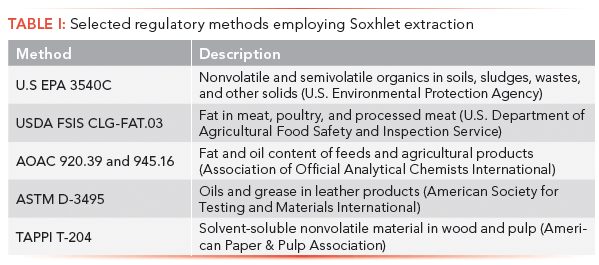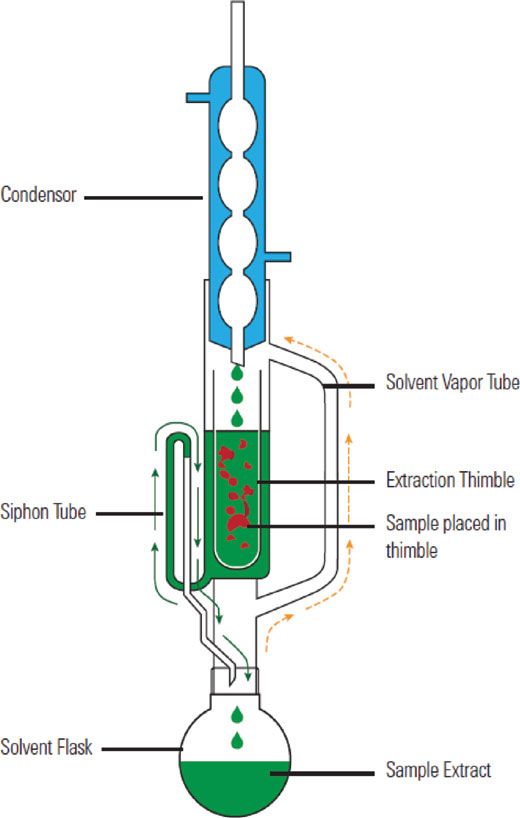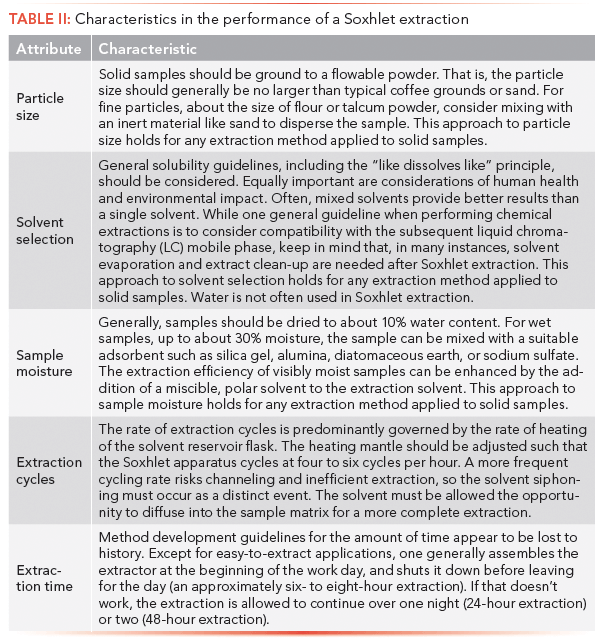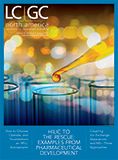Looking at the Past to Understand the Future: Soxhlet Extraction
LCGC North America
To better understand modern sample preparation techniques-such as ultrasound-assisted extraction, microwave-assisted extraction, and pressurized solvent extraction-we should look at the lessons these methods took from Soxhlet extraction.
Franz Ritter von Soxhlet is credited with inventing the extraction technique that bears his name in 1879. The method was a significant advance in the isolation of solutes from difficult-to-extract solid samples. For well over 100 years, Soxhlet extraction was considered the gold standard in the analytical extraction of solids. Regulatory agencies, trade organizations, and individual laboratories collected a wealth of data based on the technique. While still widely used, it is being replaced by a number of other techniques, such as ultrasound-assisted extraction, microwave-assisted extraction, and pressurized solvent extraction. The application of temperature, continuous flow, and preference for flowable samples that make these techniques advantageous were taken from the lessons from Soxhlet extraction, which still has much to teach us. In this month's installment, we look back at Soxhlet extraction so that analysts can better appreciate the lessons that are fundamental to today's extractions.
A highly significant advance in extraction technology, perhaps the most significant occurrence in the field for the century that followed, occurred 140 years ago with the first report of the Soxhlet extractor, a unique continuous–discontinuous device (1). This was the same year, 1879, that a 31-year old Franz Ritter von Soxhlet (Figure 1) became a professor of agricultural chemistry at the Technical University of Munich. Jensen's history on the origins of the device credits a laboratory glassblower, known only as "Herr Szombathy," as a significant contributor to this creation (2). Soxhlet is discontinuous in that it relies on a number of solvent siphon cycles. It is continuous in the sense that solvent is continuously evaporated from the solvent reservoir flask and condensed. This continuous–discontinuous process minimizes channeling of solvent through the sample, as can occur with continuous flow methods. So, Soxhlet is more correctly a batch process. The key to this solvent cycling is the constant-level siphon, based on a Pythagoras Cup. (Readers who are fans of Martyn Poliakoff's Periodic Videos may wish to view http://www.periodicvideos.com/videos/pythagoras_cup.htm.).

Figure 1: German chemist Franz Ritter von Soxhlet.
Soxhlet's original paper (1) concerned itself with the determination of milk fat. Since then, this extraction technique is widely used for fats and oils, as well as other mostly nonpolar solutes, from solid and semi-solid matrices. Because its efficiency of extraction is greater than that of other manual techniques, especially at the time, it gained broad acceptance. For example, one unsubstantiated story I've heard is about a major food company that performs 20,000 Soxhlet extractions per year across the company, as the confirmatory method after placing a modern instrumental extraction method in each of their plants. Personally, about 20 years ago, a food science colleague showed me his laboratory where about 20 Soxhlet extractors were connected to run in parallel. (Of course, he was talking with me about developing a supercritical fluid extraction method to replace his extensive use of Soxhlet.).The wide use of the Soxhlet technique for fats and oils can be gleaned from Table I, which shows selected standard methods using this approach. Because of its wide acceptance and the considerable time before suitable alternatives emerged, Soxhlet extraction is considered the benchmark to which other techniques are compared; several organizations have volumes of historic data based on Soxhlet approaches.

Operation of Soxhlet Extraction
The Soxhlet apparatus is shown in Figure 2, and the middle third of the device is the actual Soxhlet extractor. In practice, the solid sample is placed into a porous (typically cellulose) extraction thimble, positioned into the Soxhlet extractor, and the device is assembled. Solvent (shown in green in Figure 2) is added to the solvent reservoir flask, and mounted onto a heating mantle. As it boils, the solvent vapors rise through the solvent vapor tube sidearm. As the solvent vapors hit the condenser (cooled with running water or other circulating fluid), the now liquid solvent flows down onto the sample, where it may permeate into the sample matrix and dissolve the target analytes. When the liquid solvent level reaches the top of the siphon tube, the solvent–solute mixture (the extract), is syphoned away from the extractor, and back into the solvent flask. This is one extraction cycle. The solvent re-evaporates (boils), and the solutes concentrate as they are left behind in the solvent flask.

Figure 2: Diagram of a Soxhlet extractor, reproduced from reference (3).
More specific to the performance of a chemical extraction using the Soxhlet approach, details are presented in Table II (with information from references 4–9). Many of these attributes can be applied to the extraction of solids by nearly any approach, as presented later.

With this understanding of how to perform Soxhlet extraction, the advantages and disadvantages of the technique become apparent. Perhaps the most important, and underappreciated, advantage, as mentioned previously, is the historical legacy. Not only are newly developed extraction methods for solid samples typically compared with Soxhlet for acceptance, but regulatory agencies, contract laboratories, and industrial laboratories potentially have over a century of data collected based on Soxhlet extraction, and decisions are made based on these data. Related, and as suggested in Table I, several official methods issued by regulatory agencies and trade associations worldwide are based on Soxhlet extraction. Procedurally, the sample is continually exposed to fresh solvent (via the reflux) at some elevated temperature that is less than the normal boiling point. Increasing solvent temperature typically increases solute solubility, and accelerates diffusion into and out of the sample matrix. The Soxhlet apparatus is widely available from glassware and laboratory supply vendors and is inexpensive, only $200–300. The cellulose extraction thimble acts as a filter to separate the extract from the solid residue, and, with the extractor, is available in a variety of sizes to accommodate a range of sample sizes. The technique is simple to perform; any laboratory personnel can set up the apparatus, and allow the extraction to run in an unattended manner.
Despite the plethora of advantages of Soxhlet extraction, the technique has a few drawbacks that can be limiting. A Soxhlet extraction can easily take 6–48 h, and the technique is manual, though the procedure runs unattended. Even more important are the disadvantages associated with solvent use. Depending on sample size, hundreds of milliliters of solvent are used in a single extraction. This magnifies each of the solvent attributes, including safety (such as flammability) and environmental and human health concerns. As a result, Soxhlet extractors are often set up in a laboratory fume hood. Increased solvent use means increased solvent waste disposal. Both the solvent acquisition and disposal carry a significant cost. In fact, despite the low cost of the apparatus, the solvent-related expenses boost the cost per extraction up to 1.5–2 times that of alternative methods, including methods derived from Soxhlet extraction, as well as supercritical fluid extraction (SFE), microwave-assisted extraction (MAE), pressurized solvent extraction (PSE), and ultrasound-assisted extraction (UAE). The large amount of solvent generally requires evaporation, costing time, manpower, and energy, to obtain the desired extract concentration. Extraction selectivity (that is, the ability to extract the analyte of interest in exclusion of anything else) with the Soxhlet approach is solely due to the solvent used. Consequently, some type of post-extraction clean-up, such as using selective adsorbents, is often required. While the elevated temperature of extraction provides some advantages, one must also be concerned with potential thermal degradation of analytes. Lastly, while Soxhlet data have driven analytical chemistry for the past 140 years, the rise of modern instrumental approaches to extraction (SFE, MAE, PSE, and UAE) has shown, at least in some cases, that the results obtained from Soxhlet extraction are sometimes incomplete quantitatively.
Derivations of Soxhlet Extraction
With the significance of the solvent and time disadvantages of Soxhlet extraction, there have been reports of addressing these concerns while maintaining the advantages (7–9). One of these is the high-pressure approach developed by Jennings, Wohleb, and Wolters (7) and used, for example, initially as a screening tool in the development of SFE. In this approach, the entire apparatus, with some modification, is mounted inside a high-pressure vessel. A volatile solvent, like carbon dioxide, is used, and the high-pressure allows the liquid–vapor phase transition vital to creating the extraction cycles key to Soxhlet extraction. Ankom has commercialized a similar approach, using petroleum ether for fat determination.
Another derivation of Soxhlet extraction is based on the Randall method (7–9), and is commercialized by Buchi, C. Gerhardt, and Foss, going by the names automated Soxhlet, hot Soxhlet, Soxtherm, and Soxtec. The key feature of this approach is that, during the initial portion of the extraction, the extraction thimble containing the sample is immersed directly into the boiling extraction solvent. Then, the more conventional Soxhlet approach functions more as a rinse function. With this approach, solvent use decreases from hundreds of milliliters to about 50 mL, and the time from several hours to 30–60 min.
The final approaches take advantage of more intense energy sources, ultrasound or microwave, to enhance the extraction. These approaches have yet to more completely catch the attention of researchers for two reasons. First, especially with ultrasonic energy, is concern with loss of energy intensity as it is transferred to the sample. Second is the advent of the other modern instrumental approaches (SFE, MAE, PSE, and UAE) previously discussed. However, as the technical concerns are alleviated, focused microwave and ultrasound approaches to Soxhlet extraction should become increasingly viable and competitive.
Conclusions
Soxhlet extraction is approaching a century and a half of use. During this time, it has firmly established itself as the comparison benchmark as new extraction methodologies are developed. While serious concerns exist associated with the large volumes (hundreds of milliliters) of organic solvent used and the extraction time (several hours), lessons learned from the development of Soxhlet in terms of treating samples through grinding and dispersing with adsorbents, as well as solvent selection, have guided the modern approaches to analytical extraction.
References
(1) F. Soxhlet, Dingler's Polytechisches Journal 232, 461–465 (1879).
(2) W.B. Jensen, J. Chem. Ed. 84, 1913–1914 (2007).
(3) R.E. Majors, Sample Preparation Fundamentals for Chromatography, Agilent Technologies (2013).
(4) M.K.L. Bicking, Encyclopedia of Separation Science (Elsevier, London, United Kingdom, 2000). pp. 1371–1382.
(5) M.D. Luque de Castro and L.E. Garcia Ayuso, Encyclopedia of Separation Science, (Elsevier, London, United Kingdom, 2000), pp. 2701–2709.
(6) J.R. Dean, Encyclopedia of Separation Science , (Elsevier, London, United Kingdom, 2000), pp. 4592–4608.
(7) A. Zygler, M. Siominska, and J. Namiesnik, Comp. Sampling and Sample Prep. 2, 65–82 (2012).
(8) M.D. Luque de Castro and F. Priego-Capote, Comp. Sampling and Sample Prep. 2, 83–103 (2012).
(9) M.D. Luque de Castro and F. Priego-Capote, J. Chromatogr. A 1217, 2383–2389 (2010).
ABOUT THE COLUMN EDITOR
Douglas E. Raynie

Douglas E. Raynie "Sample Prep Perspectives" editor Douglas E. Raynie is a Department Head and Associate Professor at South Dakota State University. His research interests include green chemistry, alternative solvents, sample preparation, high-resolution chromatography, and bioprocessing in supercritical fluids. He earned his PhD in 1990 at Brigham Young University under the direction of Milton L. Lee. Raynie is a member of LCGC 's editorial advisory board. Direct correspondence about this column via e-mail to LCGCedit@mmhgroup.com


.png&w=3840&q=75)

.png&w=3840&q=75)



.png&w=3840&q=75)



.png&w=3840&q=75)




